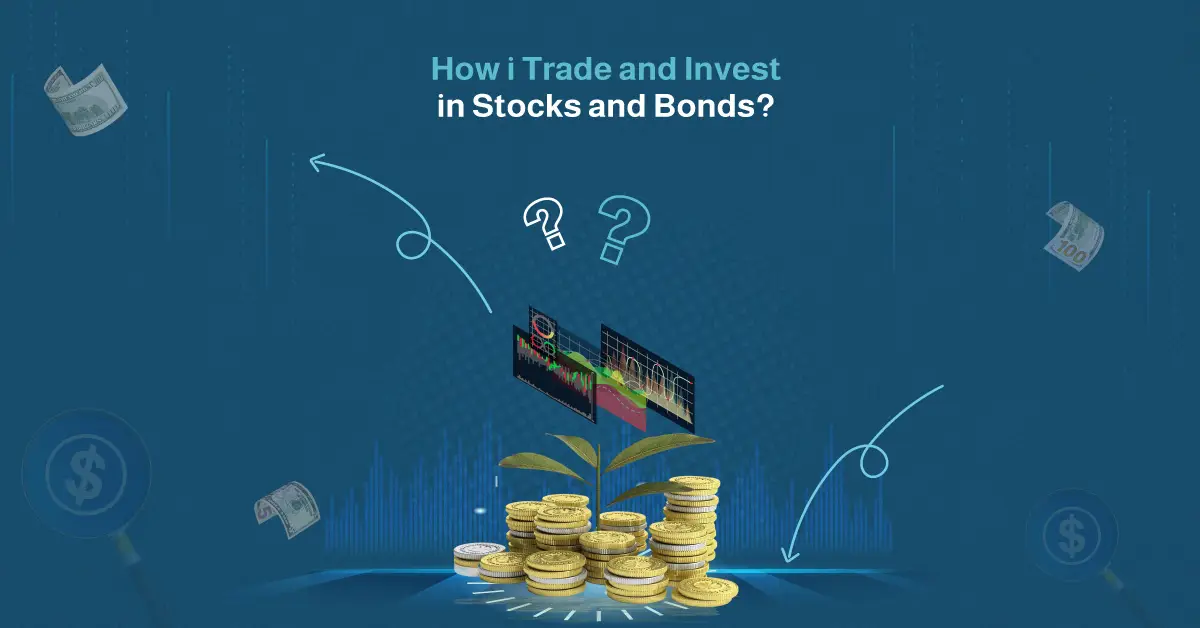For new investors, the world of stocks and bonds can feel overwhelming, with so many options available, many are unsure where to start. Many young professionals and students are looking to grow their savings, but where should they start, and how should they balance risk and reward. A clear understanding and an accessible approach can go a long way in building confidence.
In this article, we will explain step by step how I trade and invest in stocks and bonds, while offering practical strategies that are suitable for beginners and seasoned investors to apply globally. Covering essential concepts, comparing trading and long-term investment strategies, showcases platforms and tools that make investing easier, all the while advising you how to manage risk and aim for consistent returns.
While managing risks, we will have a more detailed look at the importance of diversification, combining traditional investments with alternative assets to strengthen your portfolio. Platforms like Gamma Assets provide alternative solutions, real estate-backed opportunities for a minimal investment amount. This helps many investors complement their stocks and bonds with a more stable, tangible asset.
By the end of this article, you should have a better understanding of the fundamentals, practical strategies for trading and investing, and actionable steps to help you begin your investment journey and build a diverse portfolio. No matter what your investment goal is, these insights are designed to make the process more approachable, clear, and achievable.
You can start investing now from the Gamma Asset Investment Platform
Understanding stocks and bonds: the foundation of investing
At the heart of most investment portfolios, you will find stocks and bonds. Understanding the differences is essential for learning how I trade in stocks and bonds.
Starting with stocks, these represent ownership in a company. When you buy shares in a company, you are purchasing a stake in that company and, therefore, potentially benefiting from its future growth. While stocks can offer high returns, they are also subject to high risk. The price of stocks will fluctuate with company performance, market conditions, and economic trends. Stocks are best suited for investors seeking growth over time, though the short-term volatility can be significant.
Bonds, on the other hand, are loans to a company, government, or other entity. When you buy a bond, the seller or issuer agrees to pay interest on the loan and will repay the principal at the end of the fixed period, which is when the bond matures. Bonds are known as the least risky option between the two. This is due to a lower volatility and a steadier income stream, which will help stabilize your portfolio.
The combination of stocks and bonds allows investors to balance growth and stability. Potential returns are driven by stocks and bonds offer a predictable income and risk mitigation. Having an understanding of the basics will allow you to make better-informed decisions while aligning investments with your financial goals.
While specifics may vary by market, the principles of stocks and bonds remain consistent globally. Stocks are listed on exchanges like the Tadawul, NYSE, or LSE, and bonds include government securities, corporate bonds, and other debt instruments. Understanding these fundamentals goes a long way in building the foundation for how I invest in stocks and bonds effectively.
Trading vs long-term investing: key differences and strategies
While discovering how I trade and invest in stocks and bonds, a big decision lies in whether you invest for the long-term or actively trade. Both of these options will build wealth, but they rely on completely different strategies, mindsets, and have differing risk levels.
Firstly, trading is about making the most of short-term price changes. Buying low and selling high are the opportunities that traders are searching for. This can take days, weeks, or even months of continuous monitoring, quick decision-making, and the ability to tolerate volatility.
Long-term investing is more about patience than jumping on a quick deal. Investors will focus on the underlying strength of companies or the stability of bonds, holding on to them for years, allowing them to benefit from the steady growth, dividends, and interest. This slow approach reduces the stress of daily market swings.
The table below highlights the key differences between stocks and bonds.
| Aspect | Trading | Long-term Investment |
| Timeframe | Short-term: hours to months. Positions often opened and closed quickly. | Long-term: years or decades, with a focus on compounding growth. |
| Risk | Higher volatility; potential for fast gains but also sharp losses. | Generally lower; returns are steadier but slower to build. |
| Goal | Capture profits from frequent price movements. | Build wealth gradually through appreciation, dividends, and interest. |
| Research Focus | Technical analysis, market trends, and timing. | Company fundamentals, bond ratings, and long-term outlook. |
| Investor Profile | Suits active, risk-tolerant individuals. | Best for patient investors seeking stability. |
Often, investors will make use of a blended strategy, trading a small percentage of their portfolio while keeping the majority in long-term investments. Strategies like this create balance, providing growth without taking on excess risk.
Platforms and tools to trade and invest effectively
How I trade and invest in stocks and bonds involves understanding the platforms and tools available to you as an investor. Without access to the right accounts and resources, even the best strategy will be difficult to implement.
Brokerage accounts are a good starting point; such an account will allow you, as the investor, to buy and sell both stocks and bonds. There are different brokers for different types of investors; some cater to active traders with advanced charting tools, and brokerages prioritize simplicity for beginners. Online brokers and mobile apps make opening an account easier than ever and affordable, too.
Trading platforms range in complexity, and the beginner-friendly platforms often providing intuitive dashboards, educational resources, and demo accounts to allow investors to practice. The more advanced platforms will include technical analysis tools, real-time news feeds, and customizable charts. When choosing between the options, you need to factor in your goals and whether that is short-term trading or long-term investment.
Research tools are vital to investors. Investors rely on financial news outlets, stock screeners, analyst reports, and bond rating agencies to help guide their decisions. It is important to learn how to read and interpret reports, as it will help you improve your decision-making. There are additional tools investors can use to help track and manage investments.
- Portfolio Trackers allow an investor to oversee all assets from one dashboard.
- Risk calculators provide an overview of all assets in one place.
- Mobile alerts to notify traders when prices move significantly.
Starting simple is a good idea for new investors. Make sure you choose a reliable platform with low fees, user-friendly tools, and access to both stocks and bonds. As confidence grows, additional tools can be layered in to refine strategy and improve results.
Managing risk and maximizing returns in stocks and bonds
Understanding how I trade and invest in stocks and bonds is not simply about choosing assets but also about controlling risk. We are all aware that markets rise and fall; for this reason, investors need strategies that balance protection with growth.
Diversification is possibly the most reliable method of mitigating risk. Spreading investment across different stocks, bonds, sectors, and regions to reduce the impact of a single loss. Mixing stocks and bonds usually provides stability, which is due to the fact that the two of them respond differently to market movements.
Risk tolerance is just as important. Young investors may be more accepting of the volatility of stocks in exchange for growth, but this may not be an option for investors nearing retirement; they usually prefer the steady income afforded by bonds.
Some practical methods for managing risks include:
- Using stop-loss orders to cap potential losses
- Allocating a portion of the portfolio to bonds for stability
- Rebalance regularly to keep the desired stock-to-bond mix.
- Staying disciplined instead of reacting emotionally to market swings.
Patience truly is a virtue when it comes to maximizing your returns. Stocks can deliver growth over time through reinvested dividends, while bonds provide predictable interest. By blending stocks and bonds, investors can pursue higher returns without taking on unnecessary risks. You will never avoid risk completely, but you can shape it so that it supports your long-term goals.
How Gamma Assets offers accessible real estate-backed alternatives
Most portfolios have a balance of stocks and bonds at their core, but to truly diversify, you can add alternative assets. Real estate-backed platforms like Gamma Assets allow investors to access property investment opportunities starting from as little as 500 SAR. This provides investors with a stable, tangible asset class that is less connected to the stock and bond markets.
You can reduce your overall portfolio volatility by including real estate alongside the stocks and bonds, and still pursue growth. With user-friendly tools, transparent options, and accessible entry points, Gamma Assets is making it easier than ever to diversify.
Learning how I trade and invest in stocks and bonds begins with an understanding of the basics, choosing the right strategies, using effective tools, and managing risks wisely. Combining short-term trading with long-term investing, while exploring alternative assets like real estate, offers a balanced approach to wealth building.
Starting small, remaining disciplined, and diversifying across asset classes can help investors achieve consistent growth while managing risk. With understanding, the right platforms, and a clear plan, you can navigate stocks, bonds, and complementary investments.
More topics can be read on the Gamma blog
FAQ:
What is the minimum investment to start trading stocks and bonds in Saudi Arabia?
Minimum investments vary by country and platform. Globally, brokers allow you to start with as little as $50-$100 for stocks and bonds. In Saudi Arabia, certain platforms also offer low-entry options, making it accessible for beginners.
Are there beginner-friendly platforms for trading stocks and bonds?
Yes, many global apps and online brokers cater to beginners with easy-to-use interfaces, educational resources, and demo accounts. In Saudi Arabia, platforms linked to Tadawul or mobile brokerage apps provide similar beginner-friendly experiences.
Can bonds provide safer returns compared to stocks?
Bonds are generally less volatile than stocks and can offer predictable interest income, making them a safer option for conservative investors. Stocks usually provide higher growth potential but come with greater short-term risk. Combining both can balance risk and return effectively.













